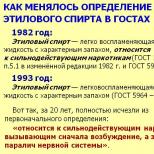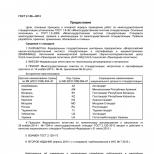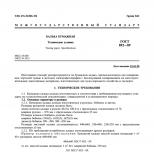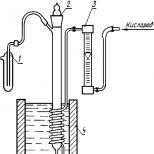Simplified calculation of evaporation and steam consumption for evaporation. Steaming the apparatus before carrying out repair hot work Calculation of the amount of steam for steaming
Industrialization agro-industrial complex on the basis of intersectoral relations and increasing its efficiency will allow to eliminate the existing agriculture disproportions, as well as to eliminate large losses of products during its production, transportation, storage, processing and sale. Under the conditions of perestroika, it is necessary to improve the form and organization of production, to improve its planning and management.
Introduction 3
1. Calculation of the structure of the herd ……… 6
2. Development master plan livestock complex. 6
2.1 Type rationale industrial premises and determining the need for them. eight
2.2 Calculation of the annual feed requirement. 9
2.3 Calculation of the storage capacity for feed and determination of the need for them. 12
2.4 Calculation of the manure storage. 15
2.5 Calculation of water consumption. 17
3. Justification and selection of mechanization and automation tools for the implementation of the basic processes of the farm. 17
3.1 Milking cows. 17
3.2 Manure removal. twenty
3.3 Stall equipment. 21
4. Design of a flow-processing line for the distribution of feed. 22
4.1 Determine the performance of PTL 22
4.2 We draw up a constructive technological scheme of the PTL. 23
4.3 We calculate and select equipment for PTL. 24
4.4 Daily work schedule of machinery and equipment. 32
4.5 Schedule of electricity consumption by hours per day. 33
5. Analysis of the indicators of the technological map. 34
Conclusion. 36
Literature 37
The work contains 1 file
4.Operational and energy calculation.
Operational and energy calculation includes the determination of energy costs for performing such technological operations as water supply, steam and heat consumption, lighting, heating, air exchange, drive of working bodies of equipment for milking, processing and storage of milk.
Tab. : Approximate rates of water consumption for technological needs
4.1 Daily consumption of cold water
defined as
,
where q 1 , q 2 ,…, Q n- the average daily rate of water consumption by a given consumer;
m 1
, m 2
,…, M n- the number of consumers of this type.
.
4.1.1 Hourly water consumption for technological needs of PTL
,
where α
- coefficient of daily irregularity of water parsing ( α
= 3…4).
4.1.2
For some technological operations, water is used in a heated state. Such water is obtained by mixing hot water heated to 90 ° C with cold tap water, the daily consumption of water heated to 90 ° C is determined by the formula:
where Q c1 , Q c2 , ..., Q cn- daily amount of mixed water, l;
t c1 , t c2 ,…, T cn- mixed water temperature, ° C;
t G- hot water temperature, (t Г = 90 ° C);
t X- cold water temperature, (t X = 8 ... 12 ° C).
4.2 Steam consumption for the technological needs of the PTL is determined by the formula:
,
where R P , R p-t , R With , R O- steam consumption, respectively, for pasteurization, steaming of a thermos tank, sterilization of milk pipes and for heating.
4.2.1 Steam consumption for pasteurization
product (milk, cream) for steam pasteurizers is determined by the formula:
,
where M- productivity of the pasteurizer,;
WITH m- heat capacity of milk,;
i and λ- heat content of steam and condensate,;
η T- thermal efficiency of the pasteurizer;
t n and t P- the initial temperature of the product and the temperature of pasteurization, ° C.
4.2.2Steam consumption for steaming
the cooling tank is defined as
where k f- the amount of steam for steaming one thermos tank
k f = 0,2 kg;
Z f- the number of thermos tanks.
.
4.2.3 Steam consumption for sterilization milk pipes and fittings is:
where k c- steam consumption for sterilization after processing each batch
milk, k c = 25 kg;
n c- the number of individual processing cycles per day.
.
2.4) Steam consumption for space heating is defined as
where k 0
- specific steam consumption for heating, k 0
= 0,5…0,75 kg / m 3
;
V P- the volume of the room, V P = a ∙ b ∙ h = 66∙150∙6 =60000 m 3
.
.
Then
4.3 calculation of farm water supply
The total average daily water consumption on the farm Q average day (m 3 / day) is determined by the formula
,
where g i- average daily water consumption by one consumer;
n i - the number of consumers.
Maximum daily water consumption.
Q max day = Q ww day * ά day
where ά day is the coefficient of daily irregularity.
ά day = 1.3
Q max day = 180 * 1.3 = 234 m 3 \ day
Maximum hourly water consumption, l \ h
where ά h = coefficient of hourly unevenness (on farms with auto-singing ά h = 2 ... .2.5; without auto-singing ά h = 4
Secondary calculation of water, l / s
L \ s
The daily flow rate of the pumping station must be equal to the maximum daily flow rate of the water flow on the farm, and the hourly flow rate of the pump station is determined by the formula:
M 3 \ h
where: t is the operating time of the pump or station per day of hours.
t = 7h
According to the Q value, we choose the type and brand of the pump 3В-27.
Specifications
Innings
Pressure
Suction lift 6.0 m
Wheel speed 1450 min -1
Weight 65 kg
Power
Power consumption of the electric motor to drive the pump, W
Required power el. motor to drive the pump, W.
where: Q us = volumetric flow rate of water m 3 \ h
p-density of water, kg \ m 3 (p = 1000 kg \ m 3)
K s = power reserve factor taking into account possible overloads during pump operation (K s = 1.1 ... .20)
g-acceleration due to gravity, m / s 2
Efficiency of the pump, moving vortex pumps:
=0,4…..0,6
Efficiency of transmission from engine to naos
1 with direct connection to the pump
4.4 calculation of daily manure yield
Determination of the daily output of manure in winter:
,
where g eh - the average daily excretion of solid excrement;
g m- average daily urine output;
g P Is the average daily bedding rate.
During the grazing period, the daily output of manure is less
Annual manure yield
where T st is the duration of the stall period (230 days);
T p - the duration of the pasture period (135 days).
4.4.1 Calculation of the manure storage
where h is the height of the manure stacking. We accept h = 2 m;
G day - the daily output of manure on the farm from the total livestock, kg. Let's take the daily output of manure corresponding to the maximum amount, i.e. in winter;
D XP - duration of storage of manure. We accept D XP = 180 days;
ρ is the density of manure, ρ = 900 kg / m 3;
φ is the filling factor of the manure storage. We take φ = 0.8.
We accept a manure storage volume V= 50 24 2.5 = 3000 m 3 .
- Calculation of ventilation.
To maintain the microclimate parameters in the optimal mode or close to optimal, for this it is necessary to remove harmful gases from the room and renew the air, that is, to carry out air exchange in accordance with the norms.
Determine the hourly air exchange by the carbon dioxide content:
where: C is the amount of carbon dioxide emitted by one animal.
We accept C = 130 dm 3 / h
M-number of animals in the room
Permissible CO content in the room air,
2.5 dm 3 / m 3
С 1 = the content of carbon dioxide in the outside air, С = 0.3 ... .0.4 dm 3 / m 3
We check the correctness of the calculation by the frequency of air exchange:
where V P is the internal volume of the room m 3:
Room with size =, b =, h =,
In livestock buildings n = 3 ... .5 h
With an air exchange rate n, we choose natural ventilation, with n = 3… .5 forced ventilation without heating the supplied air and with n - forced ventilation with heated supplied air.
Choosing ……………………… ..
Literature
- Braginets N.V., Palishkin D.A. Course and diploma design on the mechanization of animal husbandry. - M .: Agropomizdat, 1991.
- All-Union norms of technological design of cattle enterprises. ONTP 1-89 - M .: Gosagroprom of the USSR, 1989.
- Murusidze D.N., Levin A.B. Livestock production technology.
- Chugunov A.I., Pronichev N.P. etc. Methodical instructions for implementation term paper in the discipline "Technology and mechanization of animal husbandry". - M .: MGAU, 1998.
- N.P. Pronichev Methodical instructions for calculation technological maps... - M .: MGAU, 1999.
- Bogdanov V.D., Golovatov Yu.P. and other Album of diagrams and drawings of an agricultural object. - M .: MGAU, 1996.
Ventilation with air at ambient temperature can only remove volatile residues of liquid with a boiling point of no more than 300 ° C. Steaming is used to clean the equipment from residues of liquids with a high boiling point. Steaming is a more complex process than air ventilation. The devices are heated to a temperature at which heavy product residues begin to soften, melt and evaporate.
The steaming temperature is usually taken as 80 ... 90 ° C. The steam consumption required to maintain such a temperature in the gas space of the apparatus can be calculated based on the heat balance equation, which has the form:
Q 1 = Q2 + Q 3 + Q4, (6.26)
where Q 1, - heat content of steam; Q 2 - heat spent on evaporation of liquid at temperature T;"Q 3 - heat loss through the walls, roof and bottom; Q 4 - heat going to preheat the remaining liquid, gas space and the body of the apparatus to the steaming temperature.
If you do not take into account the preheating of liquid residues, gas space and the body of the device (Q 4 =0), and the steaming process is considered stationary, the heat balance equation will take the form:
Q 1 = Q 2 + Qs. (6.27)
Expanding the values of Q1 ... Q3, we get:
where α i and Fi- heat transfer coefficients and corresponding surfaces i-th elements of the structure of the apparatus; T- average volumetric temperature; T in - outside air temperature; Go- the amount of evaporated product; r 0 - heat of vaporization of the product; G B- total consumption of water vapor; r c - heat of vaporization.
From equation (6.28), having specified the flow rate and parameters of water vapor, it is possible to estimate the temperature in the steam-air space of the apparatus during its steaming:
 . (6.29)
. (6.29)
To solve the inverse problem (find the flow rate and parameters of water vapor), the steaming temperature is set. The steaming of large-volume devices without thermal insulation (for example, tanks with a capacity of more than 10,000 m 3) is extremely long and does not allow achieving the desired result.
It should be borne in mind that solid and viscous flammable residues cannot be removed by steaming, as well as by ventilation. In this case, the devices should be cleaned using safe methods of flushing the devices with solutions of technical detergents or the residues should be washed out with the product circulating in the system.
When steam is used to clean flammable products from apparatus, precautions must be taken to avoid excessive pressure build-up inside the apparatus (by removing cargo trays from breather valves and covers from skylights and manholes) and the build-up of dangerous static charges that can develop rapidly. a stream of water vapor, especially when it hits an obstacle. Therefore, in the initial period of steaming (before phlegmatization of the combustible medium in the apparatus), steam must be supplied slowly. If a fire occurs during the steaming process, it is dangerous to use water inside or outside the apparatus, as this will result in steam condensation; air from the atmosphere will penetrate into the apparatus, there will be a threat of the formation of a combustible mixture inside the apparatus and an explosion.
At enterprises, water vapor is consumed for technological and household and power purposes.
For technological purposes, deaf and live steam is used as a heat carrier. Live steam is used, for example, to boil raw materials in brewers or to heat and mix liquids by bubbling, to create excess pressure in autoclaves, as well as to change the state of aggregation of a substance (evaporation or evaporation of liquid, drying of materials, etc.). Dead steam is used in surface heat exchangers with steam heating. The steam pressure used in meat processing plants ranges from 0.15 to 1.2 MPa (1.5 ÷ 12 kg / cm 2).
For each technological operation using water vapor, its consumption is determined according to the data of the heat balance of each thermal process. In this case, data from the material balances of product calculations are used. For batch processes, the heat treatment time for each cycle is taken into account.
In each specific case, the heat load of the apparatus (consumed heat) can be determined from the heat balance of the process. For example, the heat spent on heating the product from the initial ( t n) to the final ( t j) temperatures for a continuous apparatus are determined by the formula 72:
Q = Gc (t k - t n) φ, (72)
where Q- heat spent on heating, J / s (W), i.e. thermal load of the apparatus;
G
With- specific heat capacity of the product at its average temperature, J / kg · K;
t To, t n - initial and final temperature, ° С;
φ
- coefficient taking into account heat loss to the surrounding
Wednesday ( φ
= 1.03 ÷ 1.05).
The heat capacity of the product is selected either according to well-known reference books, or calculated according to the additivity principle for multicomponent systems.
A change in the state of aggregation of a substance (solidification, melting, evaporation, condensation) is spent thermal energy, the amount of which is determined by the formula 73:
where Q- the amount of heat, J / s (W);
G- mass consumption of the product, kg / s;
r- heat of phase transition, J / kg.
Meaning r determined by reference data depending on the type of product and the type of phase transition of the substance. For example, the heat of melting of ice is taken to be r 0 = 335.2 10 3 J / kg, fat
r w = 134 · 10 3 J / kg. The heat of vaporization depends on the pressure in the working volume of the apparatus: r = f (P a). At atmospheric pressure r= 2259 · 10 3 J / kg.
For devices of continuous operation, the heat consumption is calculated per unit of time (J / s (W) - heat flux), and for devices of periodic action - per cycle of work (J). To determine the heat consumption per shift (day), it is necessary to multiply the heat flow by the operating time of the apparatus per shift, day, or by the number of operating cycles of a batch apparatus and the number of similar apparatus.
The consumption of saturated water vapor as a heat carrier under the condition of its complete condensation is determined by the equation:
where D- the amount of heating water vapor, kg (or consumption, kg / s);
Q total - total heat consumption or heat load of the heating device (kJ, kJ / s), is determined from the heat balance equation of the device;
- enthalpy of dry saturated steam and condensate, J / kg;
r- latent heat of vaporization, kJ / kg.
The consumption of live steam for mixing liquid products (bubbling) is taken at the rate of 0.25 kg / min per 1 m 2 of the apparatus cross-section.
Steam consumption for household and household needs According to this article, steam is consumed to heat water for showers, laundry, cleaning floors and equipment, and propping equipment.
Steam consumption for scraping equipment and inventory is determined by its outflow from the pipe according to the flow equation:
![]() (75)
(75)
where D w is the steam consumption for scrapping, kg / shift;
d- inner diameter of the hose (0.02 ÷ 0.03 m);
ω - speed of steam outflow from the pipe (25 ÷ 30 m / s);
ρ - vapor density, kg / m 3 (according to Vukalovich tables ρ = f(ρ ));
τ - scalding time, h (0.3 ÷ 0.5 h).
If we take in the equation τ = 1 h, then the steam consumption is determined in kg / h.
The calculation of steam consumption for all items is summarized in table 8.3.
Table 8.3 - Steam consumption, kg
| Expenditure | At one o'clock | Per shift | Per day | In year |
| Total |
The specific steam consumption is calculated using the formula 76.
Problem and initial data. Let's calculate how many kilograms of water is evaporated in each of the evaporation tanks per 100 kg of beets. This calculation has great importance, since it allows you to determine the steam consumption for evaporation and, in addition, you can then calculate the amount of heat transferred in each housing through the heating surface, and determine the size of the required heating surfaces and the dimensions of the housings.
Let us calculate a fivefold residue as the simplest, although far from the best. It is used in the case when diffusion works with a large pumping of juice (USA), for example, 140% by weight of beets, and per 100 kg of beets it is necessary to evaporate W = 120 kg of water. Let us take for this case the following system of using vaporized vapor (Table 23).
So, E1 = 7.0; E2 = 9.5 and E3 = 21.0. A significant part of the steam consumption at the plant (17.0 kg) does not depend on the evaporation: spent (return) steam is used to boil the syrup in vacuum apparatus.
Payment. Let us denote the amount of water evaporated in the V housing of the evaporation per 100 kg of beets through x kg. As a basis for all calculations, we will assume that 1 kg of heating steam evaporates 1 kg of water; for practical purposes this is close enough to reality.
Obviously, in order to evaporate x kg of water in the V building, it is necessary to send there from the IV building x kg of steam, that is, in the IV building W4 = x kg of water is also evaporated. In order to evaporate x kg of water in the IV building, it is necessary to send x kg of juice heating steam from the III building. However, in the III building of the vapor (see Fig. 135) not only these x kg of water are evaporated, which are sent in the form of steam to the IV building; juice steam of the III building also goes as extra steam, in the amount of E3 - 21.0 kg for heating some stations, a sugar factory. Consequently, in the III building is evaporated
W3 = (x + 21) kg.
Therefore, it is necessary to send (x + 21) kg of juice steam from the II building to heat the III building; in addition, E2 = 9.5 kg of extra steam is taken from the II body. Therefore, in total in the II building will evaporate
W2 = (x + 21 + 9.5) kg.
In the same way, we find that in the I building should be evaporated
W1 = (x + 21 + 9.5 + 7.0) kg.
Obviously, the sum of the water evaporated in all the evaporation tanks is equal to
W1 + W2 + W3 + W4 + W5 = W
or
x + 21 + 9.5 + 7 + x + 21 + 9.5 + x + 21 + x + x = 120,
hence x = 6.2 kg.
Knowing x, we find
W5 = 6.2; W4 = 6.2; W3 = 6.2 + 21-27.2;
W2 = 6.2 + 21 + 9.5 = 36.7;
W1 = 6.2 + 21 + 9.5 + 7 = 43.7 kg.
It is convenient to arrange the calculation of the residue as follows:
Steam consumption for evaporation. In the previous approximate calculation, it was found that 43.7 kg of water is evaporated in the 1st building. Consequently, to heat this body, D = 43.7 kg of steam (return and reduced) is also spent on 100 kg of beets.
It should be noted that this, nevertheless, quite significant steam consumption is mainly required not at all to evaporate water, but to provide steam to almost all stations of the sugar factory: the residue is the "warm heart" of the sugar factory, sending steam throughout the factory. As already mentioned, if 1 kg of juice steam is taken from any evaporation vessel, then it also corresponds to the consumption of 1 kg of fresh steam (recycle or reduced), but at the same time, as if free of charge, several kilograms of water are evaporated in several evaporation vessels.
So, if we take kg of extra pairs from different buildings of the residue (E1 + E2 + E3), then this corresponds to the consumption of the same amount of fresh steam. In addition, W5 kg of water is evaporated in the V case, which goes to the condenser in the form of steam. This steam is similar to extra steam, only it is a useless extra steam, since it only heats the cold condenser water to 40-45 ° C, which is not required at all for production. The condenser W5 kg of steam leaving the condenser obviously also corresponds to the consumption of W5 kg of live steam.
Therefore, the total steam consumption for evaporation should be equal to
D = E1 + E2 + E3 + W5,
i.e. the sum of extra pairs plus the amount of water evaporated in the V case of the vapor (or the amount of steam that went to the condenser).
Indeed, for the previous numerical example, we find
D = 7 + 9.5 + 21 + 6.2 = 43.7 kg,
that is, exactly the same value that we calculated in a different way, but here it is much clearer deciphered on what reasons the steam consumption for evaporation depends, for what purposes this consumption is required. Obviously, the steam consumption for heating stations, i.e.
E = E1 + E2 + E3 = 7 + 9.5 + 21 = 37.5 kg,
it is all the same inevitable in the form of juice or in the form of fresh steam.
Consequently, the additional steam consumption for the evaporation itself is only W5 = 6.2 kg. This is a harmful consumption of steam and heat - this steam goes to the condenser uselessly.





